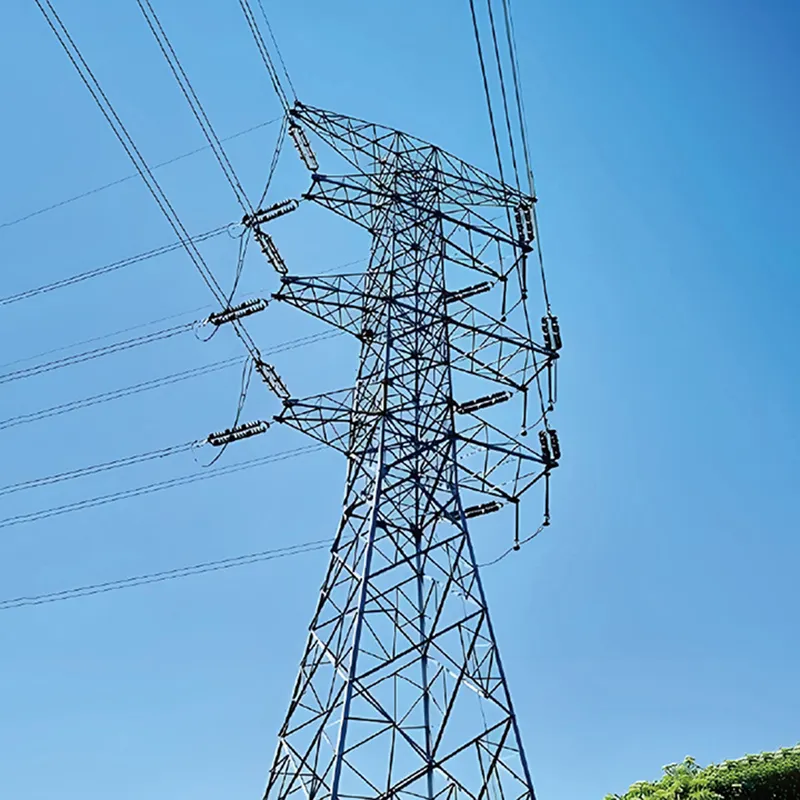ইলেকট্রিক পোলের নিরাপত্তা এবং রক্ষণাবেক্ষণের জন্য গুরুত্বপূর্ণ নির্দেশাবলী
বৈদ্যুতিক খুঁটি রক্ষণাবেক্ষণ হল বিদ্যুৎ অবকাঠামোর একটি গুরুত্বপূর্ণ দিক, যা নির্ভরযোগ্য বিদ্যুৎ বিতরণ নিশ্চিত করে এবং কর্মীদের ও সাধারণ মানুষের নিরাপত্তা রক্ষা করে। বৈদ্যুতিক খুঁটির পেশাদার রক্ষণাবেক্ষণ করা বিদ্যুৎ সরবরাহ বন্ধ হওয়া রোধ করে, নিরাপত্তা ঝুঁকি কমায় এবং এই গুরুত্বপূর্ণ উপাদানগুলির আয়ু বৃদ্ধি করে। ইউটিলিটি কোম্পানি, রক্ষণাবেক্ষণ দল এবং অবকাঠামো ব্যবস্থাপকদের জন্য সঠিক রক্ষণাবেক্ষণ পদ্ধতি এবং নিরাপত্তা প্রোটোকল সম্পর্কে জ্ঞান রাখা আবশ্যিক।
বৈদ্যুতিক খুঁটির উপাদান এবং পরিদর্শন পদ্ধতি বোঝা
বৈদ্যুতিক খুঁটির প্রধান উপাদানসমূহ
বৈদ্যুতিক খুঁটি কয়েকটি গুরুত্বপূর্ণ উপাদান নিয়ে গঠিত যা নিয়মিত পরিদর্শন ও রক্ষণাবেক্ষণের প্রয়োজন। মূল খুঁটির কাঠামো, যা সাধারণত কাঠ, কংক্রিট বা ইস্পাত দিয়ে তৈরি, তাতে ক্রসআর্ম, অন্তরক, ট্রান্সফরমার এবং পরিবাহীগুলি সমর্থন করে। প্রতিটি উপাদান বিদ্যুৎ বিতরণে একটি গুরুত্বপূর্ণ ভূমিকা পালন করে এবং নির্দিষ্ট রক্ষণাবেক্ষণের প্রয়োজন হয়। নিয়মিত বৈদ্যুতিক খুঁটির রক্ষণাবেক্ষণে খুঁটির কাঠামোগত সামগ্রী এবং সংযুক্ত সরঞ্জামগুলির অবস্থা উভয়কেই সম্বোধন করা আবশ্যিক।
বিস্তৃত পরিদর্শন প্রোটোকল
বৈদ্যুতিক খুঁটির রক্ষণাবেক্ষণের জন্য ব্যবস্থাগত পরিদর্শন পদ্ধতি প্রতিষ্ঠা করা অপরিহার্য। কাঠের খুঁটির ক্ষেত্রে সাধারণত প্রতি 3-5 বছর এবং কংক্রিট বা ইস্পাতের খুঁটির ক্ষেত্রে 5-7 বছর অন্তর পরিদর্শন করা উচিত। দৃশ্যমান পরিদর্শনের মাধ্যমে ফাটল, পচন বা প্রাণীজগতের কারণে ক্ষতির মতো সুস্পষ্ট ত্রুটিগুলি চিহ্নিত করা যায়, আবার বিশেষায়িত পরীক্ষার সরঞ্জাম অভ্যন্তরীণ পচন এবং কাঠামোগত শক্তি মূল্যায়নে সহায়তা করে। পরিদর্শনের ফলাফল নথিভুক্ত করা প্রতিটি খুঁটির জন্য একটি মূল্যবান রক্ষণাবেক্ষণ ইতিহাস তৈরি করে।
নিরাপত্তা সরঞ্জাম এবং সুরক্ষা ব্যবস্থা
আত্মীয় সুরক্ষা সরঞ্জামের প্রয়োজন
বৈদ্যুতিক খুঁটির রক্ষণাবেক্ষণের সময় কর্মীদের নিরাপত্তার জন্য উপযুক্ত ব্যক্তিগত নিরাপত্তা সরঞ্জাম (PPE) প্রয়োজন। প্রয়োজনীয় জিনিসগুলির মধ্যে রয়েছে অন্তরিত তালি, নিরাপত্তা হার্নেস, মুখরক্ষীসহ কঠিন টুপি এবং বিশেষায়িত আরোহণ সরঞ্জাম। সমস্ত নিরাপত্তা সরঞ্জাম অবশ্যই বর্তমান শিল্প মানগুলি মেনে চলবে এবং ব্যবহারের আগে নিয়মিত পরিদর্শনের অধীন হবে। রক্ষণাবেক্ষণ কার্যক্রমের সময় কর্মীদের সুরক্ষার জন্য PPE ব্যবহার এবং রক্ষণাবেক্ষণের উপর সঠিক প্রশিক্ষণ অপরিহার্য।
উন্নত নিরাপত্তা সরঞ্জাম এবং প্রযুক্তি
আধুনিক বৈদ্যুতিক খুঁটি রক্ষণাবেক্ষণে পরিশীলিত নিরাপত্তা প্রযুক্তি অন্তর্ভুক্ত করা হয়। এতে ভোল্টেজ ডিটেক্টর, তাপমাত্রা বৃদ্ধির স্থান চিহ্নিতকরণের জন্য ইনফ্রারেড ক্যামেরা এবং উন্নত গ্রাউন্ডিং সরঞ্জাম অন্তর্ভুক্ত রয়েছে। ডিজিটাল মনিটরিং ব্যবস্থা খুঁটির অবস্থা বাস্তব সময়ে ট্র্যাক করতে পারে, যা ভবিষ্যদ্বাণীমূলক রক্ষণাবেক্ষণ পদ্ধতির অনুমতি দেয়। এই প্রযুক্তিগুলি বাস্তবায়ন করা কর্মীদের নিরাপত্তা এবং রক্ষণাবেক্ষণের দক্ষতা উভয়কেই উন্নত করে।
প্রতিরোধী রক্ষণাবেক্ষণের পদক্ষেপ
নিয়মিত রক্ষণাবেক্ষণ সূচি বাস্তবায়ন
কার্যকর বৈদ্যুতিক খুঁটি রক্ষণাবেক্ষণের জন্য একটি ভালভাবে পরিকল্পিত প্রতিরোধমূলক রক্ষণাবেক্ষণ সূচি প্রয়োজন। এতে খুঁটির চারপাশে উদ্ভিদ ব্যবস্থাপনা, হার্ডওয়্যার আটানো এবং ইনসুলেটর পরিষ্কার করার মতো নিয়মিত কাজগুলি অন্তর্ভুক্ত রয়েছে। আদর্শ আবহাওয়ার শর্তাবলীতে রক্ষণাবেক্ষণের সময়সূচী নির্ধারণ এবং অন্যান্য ইউটিলিটি কাজের সাথে সমন্বয় সাধন পরিষেবার ব্যাঘাত কমাতে সাহায্য করে এবং একইসাথে বিস্তৃত রক্ষণাবেক্ষণ নিশ্চিত করে।
পরিবেশগত প্রভাব ব্যবস্থাপনা
বৈদ্যুতিক খুঁটির রক্ষণাবেক্ষণে পরিবেশগত বিবেচনাগুলি একটি গুরুত্বপূর্ণ ভূমিকা পালন করে। এর মধ্যে রয়েছে সংরক্ষণকারী চিকিত্সার সঠিক পরিচালনা, প্রতিস্থাপিত উপাদানগুলির দায়বদ্ধতার সঙ্গে বর্জন এবং চারপাশের উদ্ভিদ ও বন্যপ্রাণীদের উপর প্রভাব হ্রাস করা। টেকসই রক্ষণাবেক্ষণ অনুশীলন ইউটিলিটিগুলিকে পরিবেশগত নিয়ম মেনে চলতে সাহায্য করে যখন অবকাঠামোর নির্ভরযোগ্যতা বজায় রাখে।

জরুরি প্রতিক্রিয়া এবং মেরামতের পদ্ধতি
দ্রুত প্রতিক্রিয়া প্রোটোকল
অবিলম্বে বৈদ্যুতিক খুঁটির রক্ষণাবেক্ষণের প্রয়োজন এমন জরুরি পরিস্থিতির জন্য সুসংজ্ঞায়িত প্রতিক্রিয়া পদ্ধতির প্রয়োজন হয়। রক্ষণাবেক্ষণ দলগুলি দ্রুত মোতায়েনের জন্য প্রস্তুত থাকতে হবে, প্রয়োজনীয় যন্ত্র এবং প্রতিস্থাপনযোগ্য যন্ত্রাংশ দিয়ে সজ্জিত থাকতে হবে। স্পষ্ট যোগাযোগ চ্যানেল এবং পূর্বনির্ধারিত প্রতিক্রিয়া প্রোটোকল নিরাপত্তা মানদণ্ড বজায় রেখে জরুরি মেরামতের কার্যকর পরিচালনা নিশ্চিত করে।
নথিভুক্তকরণ এবং মূল্যায়ন
দীর্ঘমেয়াদি বৈদ্যুতিক খুঁটি রক্ষণাবেক্ষণ পরিকল্পনার জন্য জরুরি মেরামতির সঠিক ডকুমেন্টেশন অপরিহার্য। ক্ষতির কারণ, মেরামতির পদ্ধতি এবং মেরামতির পরবর্তী মূল্যায়নের বিস্তারিত রেকর্ড একই ধরনের সমস্যা প্রতিরোধ এবং রক্ষণাবেক্ষণ কৌশল উন্নত করতে সহায়তা করে। এই তথ্য নিয়ন্ত্রক অনুপালন এবং বীমা প্রয়োজনীয়তা সমর্থন করে।
খুঁটি রক্ষণাবেক্ষণে আধুনিক প্রযুক্তি
ডিজিটাল মনিটরিং সিস্টেম
ডিজিটাল মনিটরিং ক্ষমতার মাধ্যমে উন্নত প্রযুক্তি বৈদ্যুতিক খুঁটি রক্ষণাবেক্ষণকে বিপ্লবের মুখে ফেলেছে। স্মার্ট সেন্সরগুলি গাঠনিক পরিবর্তন, বৈদ্যুতিক অসামঞ্জস্য এবং খুঁটির সামগ্রিক অবস্থার ওপর প্রভাব ফেলে এমন পরিবেশগত অবস্থা শনাক্ত করতে পারে। এই সিস্টেমগুলি সক্রিয় রক্ষণাবেক্ষণ সূচি নির্ধারণকে সক্ষম করে এবং সম্ভাব্য ব্যর্থতা ঘটার আগেই তা প্রতিরোধ করতে সাহায্য করে।
ড্রোন এবং রোবটিক সহায়তা
বৈদ্যুতিক খুঁটির রক্ষণাবেক্ষণে অনাদৃত এয়ারিয়াল ভেহিকল (ইউএভি) এবং রোবটিক সিস্টেমগুলি ক্রমাগত ব্যবহৃত হচ্ছে। এই প্রযুক্তিগুলি পৌঁছানোর কঠিন জায়গাগুলির নিরাপদ পরিদর্শনের অনুমতি দেয় এবং অবস্থার মূল্যায়নের জন্য বিস্তারিত ইমেজিং প্রদান করে। কৃত্রিম বুদ্ধিমত্তার একীভূতকরণ পরিদর্শন ডেটা বিশ্লেষণ করতে এবং রক্ষণাবেক্ষণের প্রয়োজনীয়তা আরও সঠিকভাবে ভবিষ্যদ্বাণী করতে সাহায্য করে।
প্রশিক্ষণ ও সার্টিফিকেশনের প্রয়োজনীয়তা
পেশাদার সার্টিফিকেশন মান
বৈদ্যুতিক খুঁটি রক্ষণাবেক্ষণের জন্য সঠিকভাবে প্রশিক্ষিত এবং সার্টিফায়েড কর্মীদের প্রয়োজন হয়। কর্মীদের নিরাপত্তা পদ্ধতি, রক্ষণাবেক্ষণ কৌশল এবং জরুরি প্রতিক্রিয়া প্রোটোকল সম্পর্কিত ব্যাপক প্রশিক্ষণ কার্যক্রম সম্পন্ন করতে হয়। নিয়মিত দক্ষতা হালনাগাদ এবং সার্টিফিকেশন নবায়নের মাধ্যমে রক্ষণাবেক্ষণ দলগুলি শিল্পের সেরা অনুশীলন এবং নিয়ন্ত্রক প্রয়োজনীয়তার সাথে তাল মিলিয়ে চলে।
চলমান শিক্ষা এবং দক্ষতা উন্নয়ন
বৈদ্যুতিক খুঁটির রক্ষণাবেক্ষণের ক্রমবিকাশমান প্রকৃতি রক্ষণাবেক্ষণকারী কর্মীদের জন্য অব্যাহতভাবে শেখার সুযোগ প্রয়োজন। প্রশিক্ষণের মধ্যে অন্তর্ভুক্ত থাকা উচিত নতুন প্রযুক্তি, আপডেট করা নিরাপত্তা প্রোটোকল এবং উন্নত রক্ষণাবেক্ষণ কৌশল। নিয়মিত কর্মশালা এবং হাতে-কলমে অনুশীলনের সেশনগুলি দক্ষতার উচ্চ স্তর এবং নিরাপত্তা সম্পর্কে সচেতনতা বজায় রাখতে সাহায্য করে।
প্রায়শই জিজ্ঞাসিত প্রশ্নাবলী
বৈদ্যুতিক খুঁটিগুলি কত ঘন ঘন নিয়মিত পরিদর্শনের জন্য প্রয়োজন?
কাঠের খুঁটির ক্ষেত্রে সাধারণত প্রতি 3-5 বছর এবং কংক্রিট বা ইস্পাতের খুঁটির ক্ষেত্রে 5-7 বছর পর পর পরিদর্শনের প্রয়োজন হয়। তবে আবহাওয়ার অবস্থা, খুঁটির বয়স এবং স্থানীয় নিয়মাবলীর মতো কারণগুলি আরও ঘন ঘন পরিদর্শনের প্রয়োজন হতে পারে।
বৈদ্যুতিক খুঁটির ক্ষয়ক্ষতির সবথেকে সাধারণ লক্ষণগুলি কী কী?
সাধারণ লক্ষণগুলির মধ্যে রয়েছে দৃশ্যমান ফাটল বা বিভাজন, হেলে যাওয়া বা হেলানো খুঁটি, মাটির স্তরে ক্ষয় বা পচন, কাঠঠোকরা পাখির ক্ষতি এবং ঢিলা বা ক্ষতিগ্রস্ত হার্ডওয়্যার। নিয়মিত দৃশ্যমান পরিদর্শনের মাধ্যমে এই সমস্যাগুলি তাড়াতাড়ি শনাক্ত করা যেতে পারে।
বৈদ্যুতিক খুঁটির রক্ষণাবেক্ষণকারী কর্মীদের জন্য কী কী যোগ্যতা প্রয়োজন?
কর্মীদের বিশেষায়িত প্রশিক্ষণ কার্যক্রম সম্পন্ন করতে হবে, প্রাসঙ্গিক সার্টিফিকেশন অর্জন করতে হবে এবং নিরাপত্তা প্রক্রিয়া ও রক্ষণাবেক্ষণ পদ্ধতি সম্পর্কে আপডেটেড জ্ঞান বজায় রাখতে হবে। ইউটিলিটি পোলগুলিতে বৈদ্যুতিক কাজের জন্য অনেক এলাকায় নির্দিষ্ট লাইসেন্স বা সার্টিফিকেশন প্রয়োজন হয়।
সূচিপত্র
- ইলেকট্রিক পোলের নিরাপত্তা এবং রক্ষণাবেক্ষণের জন্য গুরুত্বপূর্ণ নির্দেশাবলী
- বৈদ্যুতিক খুঁটির উপাদান এবং পরিদর্শন পদ্ধতি বোঝা
- নিরাপত্তা সরঞ্জাম এবং সুরক্ষা ব্যবস্থা
- প্রতিরোধী রক্ষণাবেক্ষণের পদক্ষেপ
- জরুরি প্রতিক্রিয়া এবং মেরামতের পদ্ধতি
- খুঁটি রক্ষণাবেক্ষণে আধুনিক প্রযুক্তি
- প্রশিক্ষণ ও সার্টিফিকেশনের প্রয়োজনীয়তা
- প্রায়শই জিজ্ঞাসিত প্রশ্নাবলী

